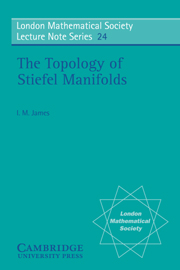Book contents
- Frontmatter
- Contents
- Preface
- 1 Introduction: algebra versus topology
- 2 The Stiefel manifolds
- 3 The auxiliary spaces
- 4 Retractible fibrations
- 5 Thom spaces
- 6 Homotopy equivariance
- 7 Cross-sections and the S-type
- 8 Relative Stiefel manifolds
- 9 Cannibalistic characteristic classes
- 10 Exponential characteristic classes
- 11 The main theorem of J-theory
- 12 The fibre suspension
- 13 Canonical automorphisms
- 14 The iterated suspension
- 15 Samelson products
- 16 The Hopf construction
- 17 The Bott suspension
- 18 The intrinsic join again
- 19 Homotopy-commutativity
- 20 The triviality problem
- 21 When is Pn, k neutral?
- 22 When is Vn, 2 neutral?
- 23 When is Vn, k neutral?
- 24 Further results and problems
- Bibliography
- Index
1 - Introduction: algebra versus topology
Published online by Cambridge University Press: 23 December 2009
- Frontmatter
- Contents
- Preface
- 1 Introduction: algebra versus topology
- 2 The Stiefel manifolds
- 3 The auxiliary spaces
- 4 Retractible fibrations
- 5 Thom spaces
- 6 Homotopy equivariance
- 7 Cross-sections and the S-type
- 8 Relative Stiefel manifolds
- 9 Cannibalistic characteristic classes
- 10 Exponential characteristic classes
- 11 The main theorem of J-theory
- 12 The fibre suspension
- 13 Canonical automorphisms
- 14 The iterated suspension
- 15 Samelson products
- 16 The Hopf construction
- 17 The Bott suspension
- 18 The intrinsic join again
- 19 Homotopy-commutativity
- 20 The triviality problem
- 21 When is Pn, k neutral?
- 22 When is Vn, 2 neutral?
- 23 When is Vn, k neutral?
- 24 Further results and problems
- Bibliography
- Index
Summary
There are three families of Stiefel manifolds, the real, the complex and the quaternionic. Readers of these notes may already be familiar with the account of their basic properties to be found in standard texts such as Steenrod and Steenrod-Epstein; a summary is given in §2 below. In this introduction we shall only be dealing with the real family, which is undoubtedly the most interesting. Some of the real Stiefel manifolds have particular topological properties, due to the existence of certain constructions which are algebraic in origin. Our aim is to try and understand, from the topological point of view, why some of them have these properties while others do not.
The notation we use is fairly standard. Thus Rm denotes euclidean m-space (m = 0, 1, …) with the usual embedding of Rm in Rm+1. The vectors v ∈ Rm such that | v | ≤ 1 form the unit ball Bm and those such that |v| = 1 form the unit sphere Sm−1. The protective space Pm−1 is obtained from Sm−1 by identifying v with -v for all v ∈ Sm−1. The group of orthogonal transformations of Rm is denoted by Om. Thus Pm−1 ⊂ Pm and Om ⊂ Om+1, in the usual way. Unless it is necessary to be more specific the base point in any space is denoted by e; orientation conventions are as in, and ιm ∈πm a (Sm) denotes the class of the identity self-map.
Following Stiefel and many others let Vn,k, where 1 ≤ k ≤ n, denote the mainfold of orthonormal k-frames in Rn.
- Type
- Chapter
- Information
- The Topology of Stiefel Manifolds , pp. 1 - 12Publisher: Cambridge University PressPrint publication year: 1977



